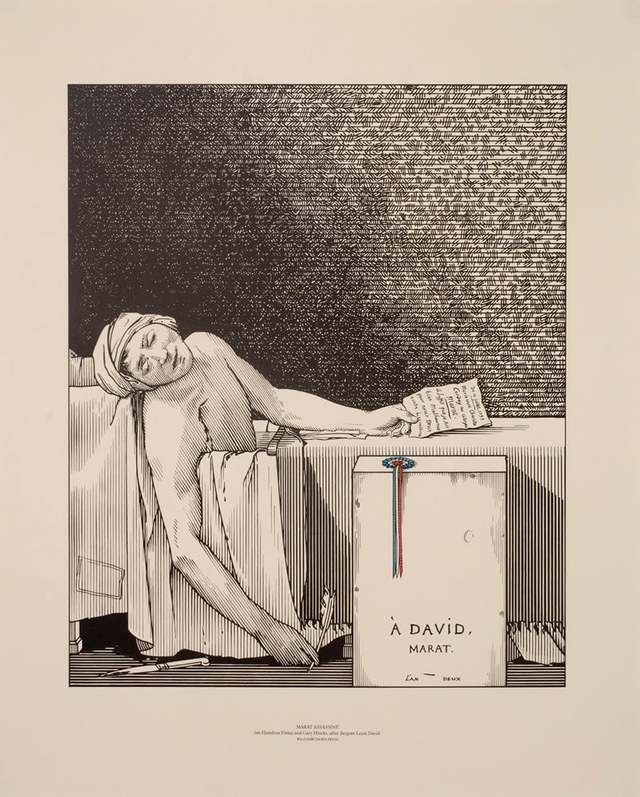Ian Hamilton Finlay
Ian Hamilton Finlay (1925-2006) was a Scottish artist, poet, and gardener known for his profound contributions to concrete poetry and conceptual art. Throughout his career, Finlay explored the intersection of language, nature, and aesthetics, creating a diverse body of work that continues to captivate audiences today.
Biography of Ian Hamilton Finlay
Ian Hamilton Finlay was born on October 28, 1925, in Nassau, Bahamas. His father smuggled alcohol from Nassau into the USA until the prohibition laws were lifted in 1933. The artist's family unsuccessfully attempted to build an orange-growing business in Florida but faced difficulties. The last one was the reason for their return to Scotland, where Ian Finlay spent most of his life.
Finlay began his education at Larchfield School near Helensburgh. Then he studied at Dollar Academy. From 1943 to 1945, Finlay's life revolved around Glasgow and London. In Glasgow, he attended art school and struck up a friendship with W.S. Graham, a renowned poet. In London, Finlay encountered the painters Robert Colquhoun and Robert MacBryde.
Finlay undertook national service with the Non-Combatant and Service Corps between 1944 and 1947. As part of his service, he traveled to post-Nazi Germany, experiencing firsthand the aftermath of the war. These experiences likely had a profound impact on his worldview and artistic sensibilities.
In the early 1950s, Finlay began writing and publishing poetry. His early work was influenced by the concrete poetry movement, which emphasized the visual arrangement of words and typography on the page. Finlay's poems often featured concise, evocative language and experimented with unconventional layouts, challenging traditional notions of poetry.
Starting from 1956, Finlay primarily resided in Edinburgh. However, he ventured to Rousay again in the spring of 1959, probably seeking inspiration or reconnecting with the place. During the mid-1950s to early 1960s, Finlay suffered from bouts of nervous illness that significantly affected his life.
Literature Practice
In 1961, Finlay founded the Wild Hawthorn Press, which became a platform for his publications and artistic endeavors. During this period, he collaborated with various artists, writers, and musicians, creating interdisciplinary works that blurred the boundaries between poetry, visual art, and music. In the spring of 1962, Finlay made a significant artistic venture by launching the visual poetry periodical "Poor. Old. Tired. Horse." (P.O.T.H). This magazine marked a milestone in his career, showcasing his innovative approach to art and literature.
By the late 1960s, he began aligning his work with different influences, moving away from avant-garde poetics. Instead, he found inspiration in architecture, the landscape gardening practices of the 18th century exemplified by figures like Shenstone and Pope, and the principles of classical philosophy.
Unique garden: Little Sparta
One of Finlay's most significant achievements was the creation of his garden, known as Little Sparta, located near Edinburgh. Little Sparta served as a living artwork, where he carefully curated the landscape and incorporated sculptural elements, inscriptions, and poetic interventions. The garden reflected Finlay's deep interest in classical literature, history, and the relationships between art and nature.
The aesthetic and ethical significance of the garden evolved through the installation of artworks that reflected Finlay's changing thematic interests. In the late 1960s and early 1970s, in the garden were incorporated elements inspired by classical concepts of culture, society, and warfare. As the years progressed, these ideas interacted with broader historical contexts, such as the French Revolution, Nazism, and modern art, particularly during the late 1970s and 1980s.
Throughout these developments, older artworks remained in place, creating a layered and nuanced environment where the newer installations interacted with the established pieces. This interplay of ideas, themes, and historical references within the garden contributed to its ever-evolving nature and served as a reflection of Finlay's artistic vision and exploration of complex concepts.
Finlay's art
During the 1980s, Ian Hamilton Finlay experienced a significant surge in international recognition and his visibility as an artist. His presence in the art world expanded exponentially, marked by a series of notable exhibitions and installations.
Between 1984 and 1985, Finlay's works were showcased in various locations, including Edinburgh, Basel, Southampton, Paris, Geneva, Australia, and Holland. His artistic endeavors transcended geographical boundaries, reaching audiences across continents.
During this period, he achieved remarkable milestones, such as securing proposals for installations at esteemed venues such as the Espace Rameau-Chapelle Sainte Marie in Nevers, France, the Villa Celle in Italy, and the Maritime Village in Swansea. These opportunities further solidified Finlay's reputation as an artist of international acclaim.
In 1985, Finlay was nominated for the prestigious Turner Prize, which served as a testament to his exceptional artistic achievements and the impact of his work on the contemporary art scene during that time. Finlay's success in the 1980s marked a significant chapter in his career, solidifying his position as a prominent and influential figure in the art world. One of his notable works created during this period is "Marat Assassiné" (1986).
Throughout his career, Finlay's work was characterized by his engagement with political and social themes. He often incorporated historical references and explored ideas related to war, conflict, and power. His artwork prompts viewers to question authority, challenge societal norms, and contemplate the relationships between language, culture, and society.
Finlay continued to work on his artistic projects until his death on March 27, 2006, in Edinburgh.
Years:
Born in 1925
Country:
United Kingdom
Gallery:
